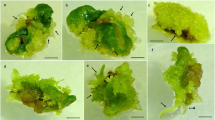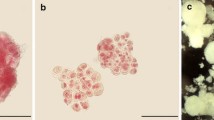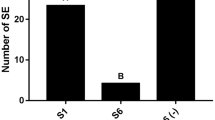Summary
Peanut seeds germinated on media supplemented with thidiazuron [TDZ: N-phenyl-N′-(1,2,3-thiadiazol-yl)urea], formed somatic embryos at the hypocotyledonary notch region by Day 35 of the culture period. Supplementation of the culture media with proline, thioproline, or glutamine reduced the total number of embryos formed, but the resulting embryos were larger, greener and had a more synchronous development than the regenerants formed on media containing TDZ alone. Analysis of the endogenous amino acid content of the germinating seeds during the induction phase of somatic embryogenesis revealed accumulation of proline to 6% of the dry seed weight. Concurrent with the emergence of the radicle, the proline concentration remained significantly elevated throughout the expression phase of embryogenesis. Several other amino acids including alanine, aspartate, asparagine, glutamate, glutamine, γ-aminobutyrate (GABA), hydroxyproline, isoleucine, threonine and valine accumulated to peak values approximately 10-fold higher than those of the controls. These results indicate that proline plays a key role in directing the route of TDZ-induced somatic embryogenesis and that TDZ effectively stimulates a cascade of metabolic events resulting in the production of specific metabolites, including amino acids, required for the regenerative process.
Similar content being viewed by others
References
Bender, L.; Joy, I. V.; Thorpe, T. A. Studies on [14-C]-glucose metabolism during shoot bud induction in cultured cotyledon explants of Pinus radiata. Physiol. Plant. 69:428–434; 1987.
Chiang, H. H.; Daandekar, A. M. Regulation of proline accumulation in Arabidopsis thaliana (L.) Heynh during development and in response to desiccation. Plant Cell Env. 18:1280–1290; 1995.
Early, R. J.; Ball, R. O. Amino acid analysis of physiological fluids and some applications in biological research. J. Anal. Purification 2:47–51; 1988.
Flasinski, S.; Rogozinska, J. Effect of water deficit on proline accumulation, protein and chlorophyll content during flowering and seed formation in winter rape. Acta Agrobotanica. 38:11–21; 1985.
Gamborg, O. L.; Miller, R. A.; Ojima, K. Nutrient requirements of suspension cultures of soybean root cells. Exp. Cell. Res. 50:151–158; 1968.
Gill, R.; Saxena, P. K. Direct somatic embryogenesis and regeneration of plants from seedling explants of peanut (Arachis hypogaea): promotive role of thidiazuron. Can. J. Bot. 70:1186–1192; 1992.
Hare, P. D.; Cress, W. A. Metabolic implications of stress-induced proline accumulation in plants. Plant Growth Reg. 21:79–102; 1997.
Kamada, H.; Harada, H. Studies on the organogenesis in carrot tissue cultures 1. Effects of growth regulators on somatic embryogenesis and root formation. Z. Pflanzen. 91:255–266; 1979.
Kamada, H.; Harada, H. Changes in endogenous amino acid compositions during somatic embryogenesis in Daucus carota L. Plant Cell Physiol. 25:27–38; 1984.
Micallef, B. J.; Shelp, B. J.; Ball, R. O. Quantification of 14C-labeled amino acids by reverse-phase high performance liquid chromatography. J. Liq. Chromatogr. 12:1281–1300; 1989.
Malik, K. A.; Saxena, P. K. Regeneration in Phaseolus vulgaris L.: high-frequency induction of direct shoot formation in intact seedlings by N6-benzylaminopurine and thidiazuron. Planta 186:384–389; 1992.
Murashige, T.; Skoog, F. A revised medium for rapid growth and bioassays with tobacco tissue cultures. Physiol. Plant. 15:473–497; 1962.
Murch, S. J.; KrishnaRaj, S.; Saxena, P. K. Thidiazuron-induced morphogenesis of regal geranium (Pelargonium domesticum): a potential stress response. Physiol. Plant. 101:183–191; 1997.
Murch, S. J.; Saxena, P. K. Modulation of mineral and fatty acid profiles during thidiazuron mediated somatic embryogenesis in peanuts (Arachis hypogaea L.). J. Plant Physiol. 151:358–361; 1997.
Murthy, B. N. S.; Murch, S. J.; Saxena, P. K. Thidiazuron-induced somatic embryogenesis in intact seedlings of peanut (Arachis hypogaea L.): endogenous growth regulator levels and significance of cotyledons. Physiol. Plant. 94:268–276; 1995.
Murthy, B. N. S.; Victor, J.; Singh, R. P.; Saxena, P. K. In vitro regeneration of chickpea (Cicer arietinum L.): stimulation of direct organogenesis and somatic embryogenesis by TDZ. J. Plant Growth Reg. 19:233–240; 1996.
Murthy, B. N. S.; Murch, S. J.; Saxena, P. K. Thidiazuron: a potent regulator of in vitro plant morphogenesis. In Vitro Cell. Dev. Biol.-Plant 34:267–275; 1998. (In press).
Ronchi, V. N.; Caligo, M. A.; Nozzolini, M.; Luccarini, G. Stimulation of carrot somatic embryogenesis by proline and serine. Plant Cell Rep. 3:210–214; 1984.
SAS Institute. Statistical Analysis Systems User’s Guide: statistics Version 6.12. SAS Institute, Cary N.C.; 1995.
Satya Narayan, V.; Nair, P. M. Metabolism, enzymology and possible roles of 4-aminobutyrate in higher plants. Phytochemistry 29:367–375; 1990.
Saxena, P. K.; Malik, K. A.; Gill, R. Induction by thidiazuron of somatic embryogenesis in intact seedlings of peanut. Planta 187:421–424; 1992.
Shetty, K.; Asano, Y. The influence of organic nitrogen sources on the induction of embryogenic callus in Agrostis alba L. J. Plant Physiol. 139:82–85; 1991.
Skoog, F.; Miller, C. O. Chemical regulation of growth organ formation in plant tissue cultures in vitro. Symp. Soc. Exp. Biol. 11:118–131; 1957.
Steward, F. C.; Mapes, M. O.; Kent, A. E.; Holsten, R. D. Growth and development of cultured plant cells. Biochemical and morphogenic studies with cells yield new evidence on their metabolism and totipotency. Science 143:20–27; 1964.
Stuart, D. A.; Strickland, S. G. Somatic embryogenesis from cell cultures of Medicago sativa L. I. The role of amino acid additions to the regeneration medium. Plant Sci. Lett. 34:165–174; 1984.
Thorpe, T. A. In vitro organogenesis and somatic embryogenesis: physiological and biochemical aspects. In: Roubelakis-Angelakis, K. A.; Tran Thanh Van, T., ed. Morphogenesis in plants. New York: Plenum Publishing Corp.; 1993.
Trigiano, R. N.; Conger, B. V. Regulation of growth and somatic embryogenesis by proline and serine in suspension cultures of Dactylis glomerata. J. Plant Physiol. 130:49–55; 1987.
Author information
Authors and Affiliations
Rights and permissions
About this article
Cite this article
Murch, S.J., Victor, J.M.R., Krishnaraj, S. et al. The role of proline in thidiazuron-induced somatic embryogenesis of peanut. In Vitro Cell.Dev.Biol.-Plant 35, 102–105 (1999). https://doi.org/10.1007/s11627-999-0018-9
Received:
Accepted:
Issue Date:
DOI: https://doi.org/10.1007/s11627-999-0018-9




